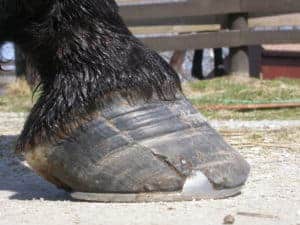
Reading Your Horse’s Inner Hoof Structures
Experts describe what’s going on inside hooves of horses with sheared heels, white line disease, abscesses, and other common hoof conditions.

Experts describe what’s going on inside hooves of horses with sheared heels, white line disease, abscesses, and other common hoof conditions.

What’s going on inside your horse’s hooves during injury or disease? Our sources reveal what they’ve learned when dealing with sheared heels, white line disease, abscesses, and other common hoof conditions.

The outer hoof’s health affects the bones and soft tissues within, and vice versa.

Hoof care experts discuss common equine foot issues, including club feet, underrun heels, and mismatched feet.

One researcher says that it is very rare to see a spontaneous quarter crack not associated with sheared heels.
The summit will offer 68 hours of hoof care education focused around the theme “Zeroing in on Soundness.”
Lameness caused by quarter cracks is a nemesis of horses and owners, and treatment is often complex.
Working to correct low heels when they begin to develop is far more successful than waiting until the horse has had no heel for a long time. Low-heeled conformation is not healthy and can compromise soundness in the short or long term.
The 18th Bluegrass Laminitis Symposium will return to Louisville, Ky., in 2007 with a full slate of international speakers sharing information on the diagnosis and treatment of laminitis and other diseases involving the equine foot. The Symposiu
The feet of wild horses have been able to adapt to their environment, while the feet of domestic horses seem to consistently fail at adapting and instead collapse, crack, flare, and bruise.
Have you ever paid attention to the way people walk? Some are pigeon-toed, others are duck-footed. Some wear the insides of their shoe heels; others do just the opposite. Yet, most are perfectly sound and healthy.
The same principle”P>Have you ever paid attention to the way people walk? Some are pigeon-toed, others are duck-footed. Some wear the insides of their shoe heels; others do ju”>Have you ever paid attention to the way people walk? Some are pigeon
An egg bar is simply an oval-shaped horseshoe. Where the heels would normally end, they keep going–but in a circular direction, creating an oval back to the shoe.
What is the relationship between chronic, severe thrush and my horse’s contracted heels?
Michael J. Wildenstein, resident farrier at Cornell University’s large animal clinic, has approximately 400 different types of therapeutic shoes hanging on the wall of his clinic. Each one, he says, was made for a particular
Stay on top of the most recent Horse Health news with
© 2022 Copyright Statement dolor sit amet, consetetur sadipscing User Terms, sed diam nonumy eirmod tempor invidunt ut labore et dolore magna aliquyam erat, sed diam voluptua. At vero eos et accusam et justo duo dolores et ea rebum. Stet clita kasd gubergren, no sea takimata sanctus est Lorem ipsum dolor sit amet.
"*" indicates required fields